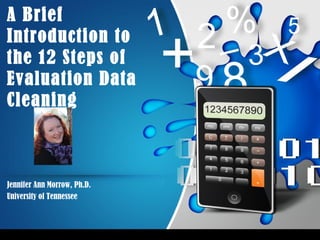
Brief Introduction to the 12 Steps of Evaluation Data Cleaning
- 1. A Brief Introduction to the 12 Steps of Evaluation Data Cleaning Jennifer Ann Morrow, Ph.D. University of Tennessee
- 2. Importance of Cleaning Data • As evaluators we need our evaluation data to be: – Accurate – Complete – High quality – Reliable – Unbiased – Valid
- 3. If We Don’t Clean Our Data • Problems that can occur: – Inaccurate/biased conclusions – Increased error – Reduced credibility – Reduced generalizability – Violation of statistical assumptions
- 4. 1: Create a Data Codebook • Contains all relevant information for your evaluation project • Suggestions for what to include: – Electronic file names – Variable names, variable labels, value labels – Complete list of modified variables – Citations for instrument sources – Project diary
- 5. 2: Create a Data Analysis Plan • Your analysis plan should list each step you will take when analyzing your data • Suggestions for what to include: – General instructions for data analysts – List of datasets – Evaluation questions – Variables used for each analysis – Specific analyses and graphics for each evaluation question
- 6. 3: Perform Initial Frequencies – Round 1 • After organizing your codebook and analysis plan you can now begin to start the data cleaning process • Conduct frequency analyses (frequencies, percentages) for EVERY variable in your evaluation dataset • Suggestion: – request a graphic (bar chart or histogram) for each variable
- 7. 4: Check for Coding Mistakes • Coding errors are any values that are not within the specified range for your variable (e.g., you have a rating scale from 1-5 and you have a value of 9) • Suggestions: – Compare all values to what is listed in your codebook – In many cases errors are unspecified missing data values
- 8. 5: Modify and Create Variables • It is now time to modify your variables so they can be used in your planned analyses • Suggestions: – Reverse code any variables that need to be merged with others that are on the opposite scale – Recode any variables to match your codebook – Create new variables (e.g., averages, total scores) to be used for future analyses
- 9. 6: Frequencies and Descriptives – Round 2 • At this step you conduct frequency analyses on every variable and descriptive analyses on every continuous variable • Suggestions: – Review the following descriptives: mean, median, mode, standard deviation, skewness, kurtosis, minimum, and maximum – Create standardized scores (i.e., Z-scores) for every continuous variable
- 10. 7: Search for Outliers • Review your standardized scores and histograms to check for outliers • Outliers are scores that deviate greatly from the mean (e.g., >/3.29/ standard deviations) and potentially can create or cover up statistical significance • Suggestions: – delete, transform, or alter (winsorize, trim, modify) your outliers
- 11. 8: Assess for Normality • For many inferential statistics (e.g., analyses of variance, regressions) your outcome (dependent) variable should be normally distributed (i.e., mean=median=mode) • Suggestions: – check to see if the values of your skewness and kurtosis are greater than /2/ – Transform the variable, use a non-parametric analysis, or modify your alpha level
- 12. 9: Dealing with Missing Data • You should always check to see if missing data is random or non-random (i.e., patterns of missing data) • Evaluation results can be misleading and less generalizable • Suggestions: – Delete cases/variables with missing data, estimate missing data, conduct analyses with and without modifying variables
- 13. 10: Examine Cell Sample Size • For many of our analyses (e.g., group difference statistics) we want to have equal sample sizes in our cells of our design • Unequal sample sizes lead to lower statistical power and reduced generalizability • Suggestions: – Collapse categories within a variable, use a non- parametric analysis, or apply a more stringent alpha level
- 14. 11: Frequencies and Descriptives – The Finale • Your data is now cleaned and ready to be summarized! • Conduct a final set of frequencies and descriptives prior to conducting your inferential statistics • Suggestion: – Use a variety of graphics and visual aids to showcase your evaluation data for your clients
- 15. 12: Assumption Testing • For some inferential statistics (e.g., correlational analyses, group difference analyses) you still need to address a few additional assumptions in order to conduct the analysis • Suggestions: – Some common assumptions are: homogeneity of variance, linearity, independence of errors, multicollinearity, and reliability
- 16. Some Helpful Resources • YouTube videos – http://www.youtube.com/watch?v=R6Cc5flsbsw – http://www.youtube.com/watch? v=5qhLDYr70MM&feature=channel&list=UL • Websites – http://clinistat.hk/internetresource.php – http://pareonline.net/getvn.asp?v=9&n=6 • Software – http://www.gnu.org/software/pspp/ – http://davidmlane.com/hyperstat/Statistical_analyses.html
- 17. Contact Information Jennifer Ann Morrow, Ph.D. Associate Professor of Evaluation, Statistics, and Measurement Department of Educational Psychology and Counseling University of Tennessee Knoxville, TN 37996-3452 Email: jamorrow@utk.edu http://web.utk.edu/~edpsych/eval_assessment/default.html
